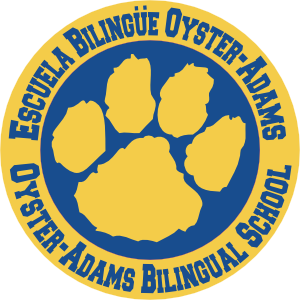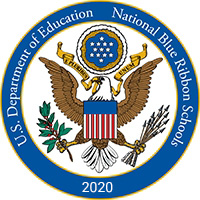Adams Campus
School Expectations
Attendance per DCPS
School attendance is required by law for all students who are at least five years of age on or before September 30th of the current school year.
Daily attendance shall include:
- participation in school-sponsored field trips
- participation in an off-site school sponsored
- approved activity during a regularly scheduled school day
- in-school suspensions;
- number of days a student receives instructional services while expelled or while serving an out-of-school suspension.
(...) School(s) must respond when students are truant. To be “truant” means that a student has 10 or more unexcused absences from school – with or without – parental knowledge, consent, or otherwise securing prior approval from the start of the school year.
OA Attendance Expectations
- Students should arrive to school by 8:40 AM to ensure they have enough time to prepare for their block 1 class.
- Students who arrive after 8:45 AM should report to the main office to receive a late pass and quickly proceed to lockers before reporting to class. Students will receive a signature for being tardy
- During the school day, a student is considered late to class if they walk in after a teacher has completed the hallway greeting. Student will receive a signature for unexcused tardies.
- Before, during, or after an excused or unexcused absence, a student should communicate with his/her teachers regarding missed assignments. It is their responsibility to retrieve and make-up missing work.
- Students must request missed work or make-up assignments for days they were absent.
- Students must ask school staff for help if you have academic or other concerns (e.g. safety or lack of transportation) preventing you from coming to school.
- Course grades or year-end promotion may be affected by unexcused absences.
Excused Absences
To excuse an absence, parents must email the attendance team at [email protected] with the appropriate documentation attached.
- Student illness (a doctor’s note if absent 5 days+) or doctor’s appointment (a doctor’s note is required);
- Death in the student’s immediate family;
- Observance of a religious holiday;
- Judicial proceeding;
- DCPS-required quarantine;
- Out-of-school suspensions.
Unexcused Absence
- Babysitting
- Running errands
- Extended travel
- Oversleeping
- Cutting classes
DCPS Response to Irregularities in Attendance
Extracted from DCPS's Attendance Policy
Each unexcused absence (full or partial absences) - Robo-call (sent from Blackboard) sent to family on each night a student has the equivalent of one day of unexcused absence.
3 cumulative partial or full-day unexcused absences - AC/AD sends 3-Day Universal Absence Letter to parent from Aspen. For virtual students only, AC/AD calls the student’s home to complete a wellness check. The wellness check must include a discussion of the student’s attendance, including the identification of technology or other barriers and any other challenges and potential resources needed to support student success.
4 cumulative partial or fullday absences (excused or unexcused) - Teacher calls the student�’s home to discuss the student’s attendance.
5 cumulative partial or fullday unexcused absences - AC/AD sends 5-Day Universal Absence Letter from Aspen to the student’s home notifying the parent/guardian that a Student Attendance Conference (SAC) will be held.
5 cumulative full-day unexcused absences - AC/AD holds an SAC with the parent and the student, if appropriate, to determine and document root causes of absences and provide related interventions and develop an Attendance Action Plan within 5 days of the referral. The AC/AD documents this meeting in Aspen. If the student has an IEP, the AC/AD must alert the local education agency representative designee (LEARD) and Case Manager. On a weekly basis, AC/AD will provide the MTSS Leadership Team with a list of all students who have reached the 5-day unexcused absence threshold, along with a report that summarizes the barriers identified during SAC meetings. Students who have reached the 5-day unexcused absence threshold are reviewed by the MTSS Leadership Team to consider whether more targeted supports are needed. If a Tier ll or lll referral is needed for any student, this referral will be made in the MTSS system and school-based MTSS intervention POC will reach out to the AC/AD for existing SAC documents.
7 cumulative full-day unexcused absences - AC/AD sends Metropolitan Police Department (MPD) Warning Letter to parent using Aspen.
10 cumulative partial or fullday unexcused absences - AC/AD sends 10-Day Universal Absence Letter to parent from Aspen. MTSS Leadership Team reviews lists of all students (ages 5-17) who have reached the 10-day unexcused absence threshold to consider whether more targeted support is needed. If a Tier ll or lll referral is needed for any student, this referral will be made in the MTSS system and school-based MTSS intervention POC will reach out to the AC/AD for existing SAC documents.
10 cumulative full-day excused absences - Note that for students aged 5 – 13 only: If all attendance interventions have been executed and documented in Aspen, AC/AD refers student to CFSA for educational neglect.
15 cumulative partial or full-day unexcused absences - AC/AD sends 15-day Universal Absence Letter to parent from Aspen.
15 cumulative full-day unexcused absences - Note that for students aged 14 – 17 only: If all interventions have been executed and documented in Aspen, AC/AD, in conjunction with their Attendance Specialist, will refer student/family to the Court Social Services Division and the Office of the Attorney General.
20 consecutive full-day unexcused absences - AC/AD sends initial withdrawal letter to parent and makes phone call to student’s home to notify parent/guardian that the student is eligible to be withdrawn from school. AC/AD must also send a final withdrawal letter to parent after all outreach has been completed notifying parent of intent to withdraw. Schools must have executed all required interventions before withdrawing a student, and schools must record all documentation in Aspen and have received approval by the principal and Instructional Superintendent. Students receiving special education services through an IEP cannot be withdrawn without the school demonstrating additional reasonable efforts to contact the parent and receiving approval from the DCPS Division of Specialized Instruction.
Middle School ALDEA
(Middle School ONLY) ALDEA (Spanish for “village”) serve as a “home base” for students and a primary point of contact for student and family throughout the school year. They meet weekly for 55-minute blocks to provide a community within the larger middle school program. Students receive academic advising (i.e. organization support, monitoring grades, and seeking help when needed), address social justice issues, and provide a forum for students to become better acquainted with a small group of students, among other topics.School-wide Morning Meetings/ 4th/5th Closing Circles
Students begin the day by engaging in a Brain Smart Start that prepares them for their daily goals. Classes meet to discuss weekly topics facilitated by their teacher. Students have the opportunity to discuss social justice issues, bullying in schools, and celebrate national holidays.Clubs
Club time is a 50-min block of time on specific periods in which all students have the opportunity to explore different extracurricular activities led by staff members.8th Grade Community Service
(Middle School ONLY) Every 8th grader is strongly encouraged to complete 10 hours of community service. OA has many service opportunities for students to engage with their community. Students choose and carry out activities voluntarily throughout the school year, which are applied to DCPS' high school graduation requirement of 100 service hours. Note: Parents must submit appropriate documentation at the receiving high school.Middle School Teachers’ Office Hours
(Middle School ONLY) Office hours are an opportunity for students to receive clarification on assignments, use resources in the classroom, or visit after an absence to collect materials from teachers. Office hours are also for:
- Checking in: “How am I doing?” “What can I do to improve my _______?”
- Increasing organization: file old papers, pick up missing assignments
- Asking questions: “I’m not sure what you mean when you say function in our lessons.”
- Clarifying: “I tried to do this assignment at home but I didn’t understand the directions.
DCPS’ Middle School Grading Scale
(Middle School ONLY)
- Middle school students will receive a letter grade (A through F) for each quarter for all classes. Advisory grades are printed on a report card that is mailed home no more than 2 weeks after the marking period ends.
- Retention can be determined by the number of failing grades in core classes (math, humanities, and science). Students meet with admin, counseling, and their family during advisories 2 and 3, if Advisory 1 and 2 grades include Fs.
Letter Grade
- A 100-93
- A- 92-90
- B+ 89-87
- B 86-83
- B- 82-80
- C+ 79-77
- C 76-73
- C- 72-70
- D+ 69-67
- D 66-64
- F 63-0
DCPS’ Grading Criteria
- All students are given an equal chance to demonstrate mastery of learning standards, including students who require special accommodations and individualized learning plans.
(Middle School ONLY)
- Engagement (10% of grade): listening, speaking, effort. Includes: constructive comments, participation in class discussions/Socratic seminars, warm up activities, attentiveness.
- Practice and Application (50% of grade): student work, assignments. Includes classwork, performance based assignments, homework, math journals, cornerstone related tasks.
- Assessments: Formative/summative – at least 4 per quarter (40% of quarter grade): includes quizzes, unit tests, compositions, cornerstones.
Sports at OA
- All forms must be completed and submitted before student makes the team, including all required immunization records.
- Additionally, coaches are in close communication with teachers, dean of students, and assistant principal regarding behavior and academic progress and will work with students to improve standing, including, but not limited to, office-hours required attendance.
- OA students may be removed from a game or practice at the discretion of the middle school dean or coach.
- (Middle School ONLY) Oyster-Adams middle school students are encouraged to maintain a 2.0 GPA or higher and not fail any classes during the grading period of the sport season.
Academic Honors
(Middle School ONLY) Each advisory, students with GPA of 3.0 or higher will receive an Honor Roll certificate.Middle School Progress Report
(Middle School ONLY) Progress Reports will be available in Aspen at the mid-point of every advisory for parent/guardian evaluation. It is the responsibility of student and parent to review the reports.
End of Term Dates
- Nov 3
- Jan 26
- April 5
- Jun 18
Lockers (Pre-Service)
Students are allowed to access their lockers a total of 4 times throughout the day:
Before block 1 or morning meeting
Materials to collect: morning classes materials (teachers share materials needed), snackBefore lunch/recess block
Materials to collect: Lunch boxes, recess itemsAfter lunch/recess block
Materials to collect: Afternoon classes materials (teachers share materials needed)At the end of the day.
Materials to collect: All items to go home
To access lockers outside of the allowed times, students should have a teacher pass. Otherwise, behavior responses will be assigned.
(Middle School ONLY) ALL students must use a combination lock to keep their belongings safe inside their locker and while in school. The school is not responsible for the loss of any item.
Arrival and Dismissal
Before the start of their academic day, students who want breakfast go to the cafeteria. Students who arrive early can go out to the playground. Every grade level should line up in front of their classroom by 8:45 am.
In the afternoon, once classes have been dismissed, all students should be out of the building by 3:45 PM (except for after-school activities or office hours, always supervised by an adult).
(Middle School ONLY) Every MS student should go through a safety screening before walking in the building. This will be conducted by the main entrance before 8:45 am.
Hallways
Students must have a pass from a staff while walking around the building during instructional time.
If student does not have a pass, behavior responses will be assigned.
It is expected that students closely monitor the volume level and behavior during their transition around the elementary or middle school classrooms.
Electronic Devices
Cell phones are brought to school at parent discretion. (Highlight)
Students who bring cell phones to school must have them turned off and stored inside their locked locker from 8:45 - 3:30 pm, including in the cafeteria and playground. Any lost or stolen cell phones are not the responsibility of the school. They are not to be seen or heard at all inside the school building, Parents who need to contact their child during the school day should call the main office.
Oyster-Adams is a no-electronics zone. That means electronics such as Gameboys, PSPs, and iPads are not are allowed in the school building at all, including the playground and veranda. E-readers (such as Nooks and Kindles) are allowed but may only be used for reading books/articles. Students who abuse the use of e-readers will have them confiscated and will no longer be allowed to use the e-reader at school. All smartwatches should be on airplane mode during the school day.
Below find the procedures and school responses for students who are seen with a smartphone (using it or inside their pockets):
First time: Phone is asked to be stored in the locker.
Second time: Phone is confiscated and submitted to behavior technician. Student receives phone at the end of the day. Parent is notified.
Third Time: Students and behavior tech create a plan, parent is notified, and infraction is logged in SBT.
Fourth Time: Phone is confiscated and submitted to parent only. Parent is asked to keep phone at home. Infraction is logged in SBT.
Fifth time: Administration will assign disciplinary response based on Chapter 25.
Lunch
In order to transition (recess/class), tables must be wiped, and the surrounding area should be cleaned. Students remain seated until they are dismissed by teachers depending on cleanliness of area.Food and Drinks
- Students are encouraged to carry a spill-proof water container to classes. The only drink allowed outside of the cafeteria is water. Soda is not allowed and will be confiscated by staff if seen anywhere in school (including in the cafeteria).
- Sweets are only allowed during lunch. These can be confiscated, if seen in other spaces.
Dress Code at OA
At OA, we believe dress codes should be clearly defined and not be gender specific. Designed to support rational and legitimate school objectives including, but not limited to, the following:
- Health and safety considerations;
- Elimination of distractions and disruptions to the education process for the individual wearing the clothes/ accessories;
- Respect for the rights of others;
- Ability to express one’s own identity.
Disciplinary Responses for Dress Code Irregularities
Students who fail to comply with the dress code will be required to:
- Adjust their clothing to meet school expectations (including borrowing/changing) into school appropriate clothing.
- Give their accessory to a teacher or administrator.
- Repeated failure to follow school expectations will result in a 1:1 conference with Assistant Principal/Dean and follow- up with family.
Requirements and Restrictions (Based in DCPS’ Chapter 24)
- Students shall, when present in areas where the possibility of injury to the student or to others exists, such as near rotating machinery, power tools, or chemicals, wear appropriate protective clothing, gloves, eye goggles, and/or other devices needed for health and safety;
- Bare or stocking feet are not permitted in schools;
- Accessories with protruding metal spikes are not be worn in school;
- Boots, flat-heeled dress shoes and enclosed toe sandals and athletic shoes are permitted at all levels;
- No student shall wear, possess, use, distribute, display or sell any clothing, jewelry, emblem, blade, symbols, sign or other things which are evidence of affiliation with drugs, alcohol, violence or gang related activities, other criminally motivated organizations, or which exhibit profane or obscene language/gestures.
- No headphones may be worn or visible.
- No flip flops or shoes without a back strap. Students should wear footwear that allows them to run/play without falling.
- Clothing changes happen in restrooms ONLY.
Tiered Disciplinary Responses at OA (Pre-service)
At OA, we see behavior as a form of communication. Students who display low social skills, will experience interventions that will provide a pause between stimuli and response (Conscious Discipline). We believe that consequences/responses are assigned with the intention to identify “pauses” and guide students through reflecting on the impact of their choices to the community. Here you can find a few behaviors and school responses.Signatures and Reflections
Discipline at OA is considered a positive EDUCATIONAL process to grow students’ self-regulation, increase long-range satisfaction, and balance between self and group interests.
Signatures are a visual way to monitor students ’community awareness and contribution. For behaviors that need further reflections, adults will provide students with a space where they both brainstorm how to productively contribute to the community after signatures. 3 signatures in a week will result in a reflection.
Families are responsible for checking student agendas on a weekly basis. We strongly encourage families to have conversations about the week’s progress and overall goals.
Students Privacy and Interventions
Student and family privacy is important to us. Be aware that only the student and family who are assigned a disciplinary response are provided with this information.
At OA we believe in equity in academics and discipline; Students receive the necessary support depending on their individual need. This means that not every student is provided with the same number of interventions in order to be successful.






